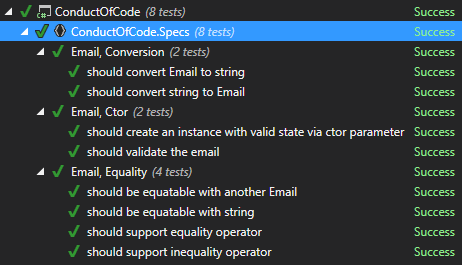Entities and Value Objects in C# for DDD
Last week I went to a meetup arranged by Swenug about DDD. I got reminded of the concept behind Entities and Value Objects and the code that we wrote at my previous job.
The scope of this post is to focus on constructors, validation and the protection of the domain.
You can view the example code in this post at https://github.com/hlaueriksson/ConductOfCode
Domain Driven Design
The term was coined by Eric Evans. Check out his book on the subject.
With DDD we
focus on the core domain and domain logic
and value the
collaboration between technical and domain experts
Two important building blocks when we talk about code are entities and value objects.
Entities
An object fundamentally defined not by its attributes, but by a thread of continuity and identity.
An entity:
- has an identity
- contains value objects
- may contain other entities
- can be mutable
Lets use Customer as an example:
Our customer has an identity and two value objects. All of this state is passed via the parameterized constructor. There is no default constructor. The properties are read-only. This makes it possible to do validation. We make sure that created customers are in a valid state and are kept in a valid state. We make sure to fail-fast.
Our customer is immutable, but it doesn’t need to be. In a real code base the customer class should encapsulate its own domain logic. This makes it is easier to protect the entity from invalid state.
Specs
It is nice to be confident of the validation in your entities by test-driving the code.
I’m using Machine.Specifications as the test framework in this blog post. The test result looks like this:

Debugger Display
One useful thing while debugging code that interacts with your entities is the DebuggerDisplay attribute.
In the example with our customer we will display the email for quick identification.

Value Objects
An object that describes some characteristic or attribute but carries no concept of identity.
A value object:
- does not have an identity
- must be immutable
Continuing with the Customer example. Our customer has a name:
Here we group the first and last name into a value object.
We don’t store them directly as separate properties in the customer.
This has some advantages.
We can reuse Name in other entities.
We can validate and make sure that when they are created, they end up in a valid state.
We make sure to fail-fast.
Once created, the name is immutable.
Let’s continue with email:
Apart from using the customer Id, the email can also be a way of identification. And wouldn’t it be convenient to sometimes just use a string when dealing with emails.
Conversion Operators
In the example above, Email has implicit conversion operators from and to string.
It can be very convenient to pass in email as a string to the customer constructor. The string will automatically be converted into an email object.
Equality Operators
If we are using email as way of identifying customers, then we benefit from:
- overriding the
Equalsmethod - implementing the
IEquatable<T>interface - implementing the equality (
==) and inequality (!=) operators
Specs


AutoFixture
AutoFixture helps you to
write maintainable unit tests, faster.
It is a popular library that reduce the setup / arrange code in your tests
by making it easier to create object graphs containing test data.
Can AutoFixture handle the creation of entities and value objects without default constructors and with read-only properties? How can we make sure the validation does not fail when creating entities and value objects?

AutoFixture:
- can handle parameterized constructors
- can handle read-only properties
- can not handle validation errors, but can help you avoid them
We can use the Register method to specify a creation function to avoid validation errors and handle read-only properties.
AutoFixture is a great tool to use when the constructor signatures of your entities and value objects keeps on changing. You can avoid a lot of compilation errors in your tests when you refactor the constructors.
AutoMapper
AutoMapper is a
convention-based object-object mapper.
It is a popular library that
takes out all of the fuss of mapping one object to another.
Can AutoMapper handle the mapping of entities and value objects without default constructors and with read-only properties? What happens if validation fails when mapping entities and value objects?
Let’s try to map our Customer, Name and Email to and from the corresponding data transfer objects.
The DTOs are just POCO classes.

AutoMapper:
- can handle parameterized constructors
- can handle read-only properties
- can not handle validation errors
The mapping fails if a DTO is in an invalid state. No big surprise. You must deal with this yourself.
Json.NET
Json.NET is a
high-performance JSON framework for .NET
It is a popular library that can
serialize and deserialize any .NET object
Can Json.NET handle deserialization of entities and value objects without default constructors and with read-only properties? What happens if validation fails when deserializing entities and value objects?

Json.NET:
- can handle parameterized constructors
- can handle read-only properties
- can not handle validation errors
The deserialization fails if an entity or value object is in an invalid state. No big surprise. You must deal with this yourself.